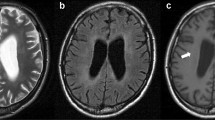Summary
MELAS syndrome is a distinct clinical entity belonging to a group of mitochondrial encephalomyopathies characterized by the tetrad of myopathy, encephalopathy, lactic acidosis, and stroke-like episodes. Computed tomography (CT) and magnetic resonance (MR) findings are reviewed in a patient with MELAS. Serial CT studies demonstrated multiple “migrating” infarcts in various stages of evolution involving primarily the posterior temporal and occipital regions. MR was more sensitive than CT in demonstrating the number and extent of cortical lesions in this disease entity.
Similar content being viewed by others
References
Pavlakis SG, Phillips PC, DiMauro S, et al. (1984) Mitochondrial myopathy, encephalopathy, lactic acidosis, and strokelike episodes: a distinctive clinical syndrome. Ann Neurol 16:481–488
Fukuhara N, Tokuguchi S, Shirakawa K, et al. (1980) Myoclonus epilepsy associated with ragged red fibers: disease entity or a syndrome? Light and electronmicrographic studies of two cases and review of the literature. J Neurol Sci 47:117–133
Kearns TP, Sayre GP (1958) Retinitis pigmentosa, external opthalmoplegia, and complete heart block: unusual syndrome with histologic study in one of two cases. Arch Opthalmol 60:280–289
Shapira Y, Harel S, Russell A (1977) Mitochondrial encephalomyopathies: a group of neuromuscular disorders with defects in oxidative metabolism. Isr J Med Sci 13:161–163
Driscoll PF, Larsen PD, Gruber AB (1987) MELAS syndrome involving a mother and two children. Arch Neurol 44:971–973
Hasuo K, Tamura S, Yasumori K, et al. (1987) Computed tomography and angiography in MELAS (mitochondrial myopathy, encephalopathy, lactic acidosis, and stroke-like episodes); report of 3 cases. Neuroradiology 29:393–397
Morgan-Hughes JA, Hayes DJ, Clark JB, et al. (1982) Mitochondrial encephalomyopathies: biochemical studies in two cases revealing defects in the respiratory chain. Brain 105:553–582
Hart Z, Change C, Perrin E, et al. (1977) Familial poliodystrophy, mitochondrial myopathy, and lactic acidemia. Arch Neurol 34:180–185
Kobayashi Y, Miyabiyashi S, Takada G, et al. (1982) Ultrastructural study of the childhood mitochondrial myopathic syndrome associated with lactic acidosis. Eur J Pediatr 139:25–30
Kuriyama M, Igata A (1985) Mitochondrial encephalopathy, lactic acidosis, and strokelike syndrome (MELAS) Ann Neurol 18: 625–626
Yamamoto T, Beppu H, Tsubaki T (1984) Mitochondrial encephalomyopathy: fluctuating symptoms and CT. Neurology 34: 1456–1460
Land JM, Morgan-Hughes JA, Clark JB (1981) Mitochondrial myopathy: biochemical studies revealing a deficiency of NADH-cytochrome b reductase activity. J Neurol Sci 50:1–13
Riggs JE, Shochet SS, Fakadej AV, et al. (1984) Mitochondrial encephalomyopathy with decreased succinate-cytochrome c reductase activity. Neurology (Cleveland) 34:48–53
Schotland DL, DiMauro S, Bonilla E, et al. (1976) Neuromuscular disorder associated with a defect in mitochondrial energy supply. Arch Neurol 33:475–479
Author information
Authors and Affiliations
Rights and permissions
About this article
Cite this article
Rosen, L., Phillips, S. & Enzmann, D. Magnetic resonance imaging in MELAS syndrome. Neuroradiology 32, 168–171 (1990). https://doi.org/10.1007/BF00588572
Received:
Issue Date:
DOI: https://doi.org/10.1007/BF00588572




